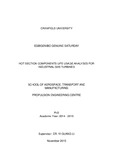JavaScript is disabled for your browser. Some features of this site may not work without it.
| dc.contributor.advisor | Li, Yiguang | |
| dc.contributor.author | Saturday, Egbigenibo Genuine | |
| dc.date.accessioned | 2016-05-12T10:40:03Z | |
| dc.date.available | 2016-05-12T10:40:03Z | |
| dc.date.issued | 2015-11 | |
| dc.identifier.uri | http://dspace.lib.cranfield.ac.uk/handle/1826/9884 | |
| dc.description.abstract | Industrial gas turbines generally operate at a bit stable power levels and the hot section critical components, especially high pressure turbine blades are prone to failure due to creep. In some cases, plants are frequently shut down, thus, in addition to creep low cycle fatigue failure equally sets in. Avoiding failure calls for proper monitoring of how the lives of these components are being consumed. Efforts are thus being made to estimate the life of the critical components of the gas turbine, but, the accuracy of the life prediction methods employed has been an issue. In view of the above observations, in this research, a platform has been developed to simultaneously examine engine life consumption due to creep, fatigue and creep-fatigue interaction exploiting relative life analysis where the engine life calculated is compared to a reference life in each failure mode. The results obtained are life analysis factors which indicate how well the engine is being operated. The Larson-Miller Parameter method is used for the creep life consumption analysis, the modified universal slopes method is applied in the low cycle fatigue life estimation while Taira's linear accumulation method is adopted for creep-fatigue interaction life calculation. Fatigue cycles counting model is developed to estimate the fatigue cycles accumulated in any period of engine operation. Blade thermal and stress models are developed together with a data acquisition and pre-processing module to make the life calculations possible. The developed models and the life analysis algorithms are implemented in PYTHIA, Cranfield University's in-house gas turbine performance and diagnostics software to ensure that reliable simulation results are obtained for life analysis. The developed life analysis techniques are applied to several months of real engine operation data, using LM2500+ engine operated by Manx Utilities at the Isle of Man to test the applicability and the feasibility of the methods. The developed algorithms provide quick evaluation and tracking of engine life. The lifing algorithms developed in this research could be applied to different engines. The relative influences of different factors affecting engine life consumption were investigated by considering each effect on engine life consumtion at different engine operation conditions and it was observed that shaft power level has significant impact on engine life consumption while compressor degradation has more impact on engine life consumption than high pressure turbine degradation. The lifing methodologies developed in this work will help engine operators in their engine conditions monitoring and condition-based maintenance. | en_UK |
| dc.language.iso | en | en_UK |
| dc.publisher | Cranfield University | en_UK |
| dc.rights | © Cranfield University, 2015. All rights reserved. No part of this publication may be reproduced without the written permission of the copyright holder. | en_UK |
| dc.title | Hot section components life usage analyses for industrial gas turbines | en_UK |
| dc.type | Thesis or dissertation | en_UK |
| dc.type.qualificationlevel | Doctoral | en_UK |
| dc.type.qualificationname | PhD | en_UK |
